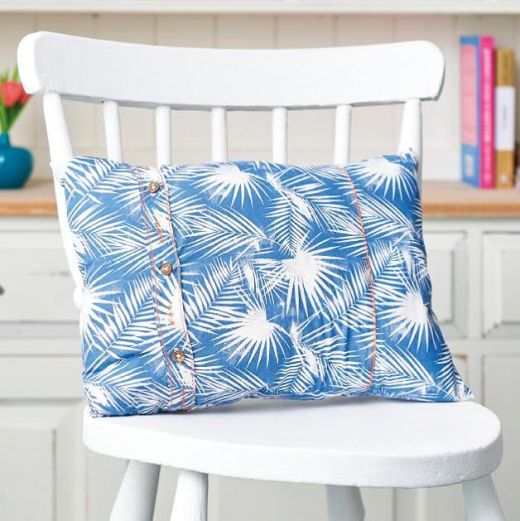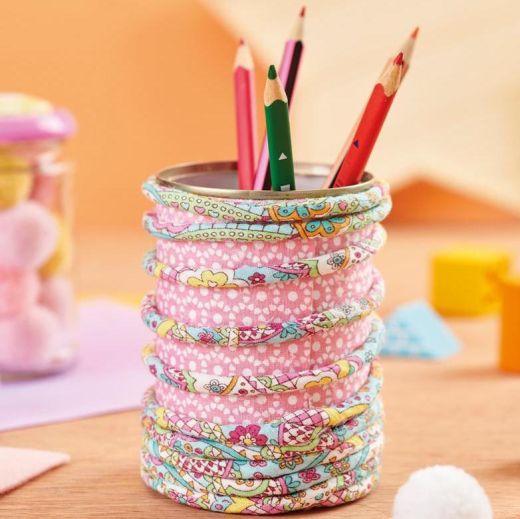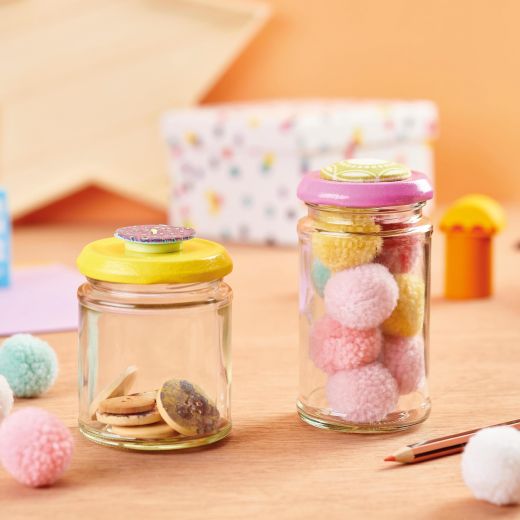Upcycle old or unwanted items into our three stylish makes
What you need...
- Boy’s shirt with button fastening
400g food can with white lining
Glass screw top jars
Assorted fabrics
Cushion pad
Matching and contrasting machine thread
Embroidery thread
4mm piping cord, 5m
Decorative buttons
Sewing machine
Piping or zipper foot
Metal paint
Bradawl and hammer
Spray adhesive
Hot glue gun
instructions
-
Cushion Cover - 1. The size of the cushion cover will be dictated by the shirt. The one used for this project was for a boy aged 7-8 years, which produced a cover measuring 28cm x 38cm. If the base of the shirt has a curved hemline, cut it away into a straight edge. Draw a line across the shirt under the base of the armholes, then cut away the sleeves and the top of the shirt to form an even rectangular strip.
2. The shirt used for this project had orange contrast thread stitching along the side seams. To add to this detail, a decorative stitch on the sewing machine was used to embellish between the buttonholes, then straight edge-stitched lines were worked on either side of the buttonhole strip.
3. Fasten the shirt buttons, then turn the fabric to the wrong side and flatten to form a rectangle. Position the button fastening towards one side of the rectangle and pin in place. Before stitching the two raw edges together at the top and base, unfasten one of the buttons. This will allow you to turn the cover right side out through the button fastening. Tease out the corners and press the cover flat. Unfasten all the buttons, push the cushion pad into the cover, then do up the buttons again to close. -
Pencil Holder - 1. Cut a rectangle of fabric measuring the circumference of your food can plus 2cm x the height. Fold in 1cm along one of the shorter edges and stick in place. Spray the reverse of the fabric rectangle with adhesive and stick this to the outer surface of the can, overlapping the folded edge over the raw edge.
2. The fabric covered cord used for this project is called welt cording and you will need double the amount of piping cord to produce half the amount of welt cord. For this project, 2.5m of completed welt cord was needed to wind around the can which meant you will need to start with a 5m length of piping cord.
3. Next you will need to cut bias strips of a contrasting fabric to the one used on the can, cut at a 45° angle from the selvedge edge. Cut the strips 4cm wide, then join them to form one continuous 2.5m length of bias binding.
4. Attach a piping or zipper foot to your sewing machine. Find the centre of the 5m length of piping cord. At this point, wrap the bias binding around the cord with the wrong side of the fabric facing uppermost. Stitch right through the end of the bias binding and through the cord, making sure that this stitching is secure and will not come undone.
5. Turn the cord and bias binding towards you, wrap the bias around the cord matching the raw edges together and start stitching as close to the cord as you can without sewing into the cord. Carry on stitching to the end of the cord and bias binding.
6. Start to ruche the bias binding over the cord to the point where the binding and cord were stitched together in the centre. It’s a little tricky getting this started but what you’re doing is pulling the bias binding over onto the remaining uncovered part of the cord to eventually reveal the right side of the bias binding and a fabric covered cord is produced.
7. Cut away the uncovered piping cord. Using a hot glue gun, and starting at the base, begin to stick the welt cord around the can. Anchor the end of the cord with a dot of glue, leave a few centimetres, apply another dot of glue and stick the next part of the cord. Start wrapping the cord tightly around the can and after five rounds begin to open out the distance between to form into a spiral. Tuck and glue the remaining end at the top of the can under the earlier round of cord. -
Storage Jars - 1. All types of paint can be used to paint the lids of the jars. A spray enamel or metal paint would give you a smooth even surface. Craft paints can also be used, such as ceramic paints that can be applied with a small sponge. Some paints may need a ‘key’ to enable the colour to adhere, so lightly sand the lid beforehand. When the paint has been applied, leave to dry thoroughly.
2. The pink lidded jar was decorated with a covered button. Cut out a disc of contrasting fabric large enough for a large cover button and with a needle and thread, make a running stitch around the edge. Place the button onto the wrong side of the disc and pull up the running stitch encasing the button in the fabric. Pull up tightly and tie the thread securely.
3. Make a hole through the centre of the lid with a bradawl or a nail and a hammer. Push the shank of the button through the hole, then push on the button backing which should secure the button to the lid.
4. For the yellow lid, two buttons were stacked one on top of the other. Make two holes in the lid and stitch the buttons in place with yellow embroidery thread, knotting off securely.


































